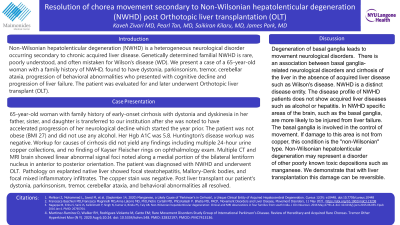Back


Poster Session B - Monday Morning
Category: Liver
B0543 - Resolution of Chorea Movement Secondary to Non-Wilsonian Hepatolenticular Degeneration (NWHD) Post Orthotopic Liver Transplantation (OLT)
Monday, October 24, 2022
10:00 AM – 12:00 PM ET
Location: Crown Ballroom

Has Audio

Kaveh Zivari, MD
Maimonides Medical Center
Brooklyn, NY
Presenting Author(s)
Kaveh Zivari, MD1, Pearl Tan, MD2, Saikiran Kilaru, MD3, James Park, MD1
1Maimonides Medical Center, Brooklyn, NY; 2New York University, Manhatan, NY; 3New York University Langone Medical Center, New York, NY
Introduction: Non-Wilsonian hepatolenticular degeneration (NWHD) is a heterogeneous neurological disorder occurring secondary to chronic acquired liver disease. Genetically determined familial NWHD is rare, poorly understood, and often mistaken for Wilson's disease (WD). We present a case of a 65-year-old woman with a family history of NWHD, found to have dystonia, parkinsonism, tremor, cerebellar ataxia, progression of behavioral abnormalities who presented with cognitive decline and progression of liver failure. The patient was evaluated for and later underwent Orthotopic liver transplant (OLT)
Case Description/Methods: 65-year-old woman with family history of early-onset cirrhosis with dystonia and dyskinesia in her father, sister, and daughter is transferred to our institution after she was noted to have accelerated progression of her neurological decline which started the year prior. The patient was not obese (BMI 27) and did not use any alcohol. Huntington's disease workup was negative. Workup for causes of cirrhosis did not yield any findings including multiple 24-hour urine copper collections, and no finding of Kayser Fleischer rings on ophthalmology exam. Multiple CT and MRI brain showed linear abnormal signal foci noted along a medial portion of the bilateral lentiform nucleus in anterior to posterior orientation. The patient was diagnosed with NWHD and underwent OLT. Pathology on explanted native liver showed focal steatohepatitis, Mallory-Denk bodies, and focal mixed inflammatory infiltrates. The copper stain was negative. Post liver transplant our patient's dystonia, parkinsonism, tremor, cerebellar ataxia, and behavioral abnormalities all resolved.
Discussion: Degeneration of basal ganglia leads to movement neurological disorders. There is an association between basal ganglia-related neurological disorders and cirrhosis of the liver in the absence of acquired liver disease such as Wilson's disease. NWHD is a distinct disease entity. Specific areas of the brain, such as the basal ganglia, are more likely to be injured from liver failure. The basal ganglia is involved in control of movement. If damage to this area is not from copper, this condition is the "non-Wilsonian" type. Non-Wilsonian hepatolenticular degeneration may represent a disorder of other poorly known toxic depositions. We demonstrate that with liver transplantation this damage can be reversible.
Disclosures:
Kaveh Zivari, MD1, Pearl Tan, MD2, Saikiran Kilaru, MD3, James Park, MD1. B0543 - Resolution of Chorea Movement Secondary to Non-Wilsonian Hepatolenticular Degeneration (NWHD) Post Orthotopic Liver Transplantation (OLT), ACG 2022 Annual Scientific Meeting Abstracts. Charlotte, NC: American College of Gastroenterology.
1Maimonides Medical Center, Brooklyn, NY; 2New York University, Manhatan, NY; 3New York University Langone Medical Center, New York, NY
Introduction: Non-Wilsonian hepatolenticular degeneration (NWHD) is a heterogeneous neurological disorder occurring secondary to chronic acquired liver disease. Genetically determined familial NWHD is rare, poorly understood, and often mistaken for Wilson's disease (WD). We present a case of a 65-year-old woman with a family history of NWHD, found to have dystonia, parkinsonism, tremor, cerebellar ataxia, progression of behavioral abnormalities who presented with cognitive decline and progression of liver failure. The patient was evaluated for and later underwent Orthotopic liver transplant (OLT)
Case Description/Methods: 65-year-old woman with family history of early-onset cirrhosis with dystonia and dyskinesia in her father, sister, and daughter is transferred to our institution after she was noted to have accelerated progression of her neurological decline which started the year prior. The patient was not obese (BMI 27) and did not use any alcohol. Huntington's disease workup was negative. Workup for causes of cirrhosis did not yield any findings including multiple 24-hour urine copper collections, and no finding of Kayser Fleischer rings on ophthalmology exam. Multiple CT and MRI brain showed linear abnormal signal foci noted along a medial portion of the bilateral lentiform nucleus in anterior to posterior orientation. The patient was diagnosed with NWHD and underwent OLT. Pathology on explanted native liver showed focal steatohepatitis, Mallory-Denk bodies, and focal mixed inflammatory infiltrates. The copper stain was negative. Post liver transplant our patient's dystonia, parkinsonism, tremor, cerebellar ataxia, and behavioral abnormalities all resolved.
Discussion: Degeneration of basal ganglia leads to movement neurological disorders. There is an association between basal ganglia-related neurological disorders and cirrhosis of the liver in the absence of acquired liver disease such as Wilson's disease. NWHD is a distinct disease entity. Specific areas of the brain, such as the basal ganglia, are more likely to be injured from liver failure. The basal ganglia is involved in control of movement. If damage to this area is not from copper, this condition is the "non-Wilsonian" type. Non-Wilsonian hepatolenticular degeneration may represent a disorder of other poorly known toxic depositions. We demonstrate that with liver transplantation this damage can be reversible.
Disclosures:
Kaveh Zivari indicated no relevant financial relationships.
Pearl Tan indicated no relevant financial relationships.
Saikiran Kilaru indicated no relevant financial relationships.
James Park indicated no relevant financial relationships.
Kaveh Zivari, MD1, Pearl Tan, MD2, Saikiran Kilaru, MD3, James Park, MD1. B0543 - Resolution of Chorea Movement Secondary to Non-Wilsonian Hepatolenticular Degeneration (NWHD) Post Orthotopic Liver Transplantation (OLT), ACG 2022 Annual Scientific Meeting Abstracts. Charlotte, NC: American College of Gastroenterology.
